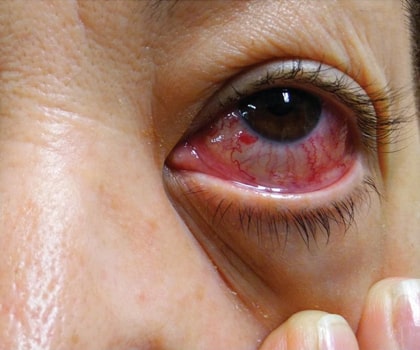Carotid Cavernous Fistula Treatment by Vascular Surgeons
Abnormal connections between the blood vessels that take blood to and from the brain is in other words known as Carotid cavernous fistulas (CCFs). It is a type of Arteriovenous Fistula, where the arterial blood enters the cavernous sinus with high pressure, and the normal venous return to the cavernous sinus are disrupted. CCFs are classified as either indirect or Dural) or direct. Indirect CCFs are occurred suddenly and have no known cause.

Our Vascular Surgeons are good experts in Carotid cavernous fistula treatments with the best quality and care
Direct CCFs may result from:
- Trauma
- Rupture of a cavernous carotid aneurysm
Symptoms of Carotid Cavernous Fistulas may include:
- Bulging eyes
- Deteriorating vision
- Ringing in the ears
Treatments solely depend on the type of CCF. General Treatment options may include:
Embolization
Our Vascular surgeons give the treatment to the patients, who are having the symptoms of Carotid Cavernous Fistula by the procedure called Embolization. Embolization is generally an invasive procedure where the small catheter or a tube is inserted in the groin. This is then passed to the blood vessels in the brain which helps to cease the blood flow by guiding the small coils or detachable silicon balloons through the arteries.
Q. What are the Types of Carotid-Cavernous Sinus Fistula?
A. CCF may be classified as direct or indirect.
- Direct CCF
Direct CCFs form between the part of your internal carotid artery and the veins inside your cavernous sinus. In this type of fistula, there is usually a high blood flow rate. This type is most common.
- Indirect CCF
Indirect Carotid Cavernous Fistula forms between the branches of the carotid artery and the Cavernous Sinus Veins in the membranes that enclose the brain. The rate of blood flow in these fistulas is usually low.
Q. What are the Symptoms of Carotid-Cavernous Sinus Fistula?
A. After the formation of Indirect CCF, the rate of blood flow is very relatively low, which causes fever and the symptoms which aren’t serious. Direct CCFs usually require more urgent attention. For both types, symptoms may include:
- A bulging eye, which may pulsate
- A red eye
- An eye that protrudes forwards
- Double vision
- Loss of vision
- Weak or missing eye movements
- Pains in your face
- Ringing in your ears
- Headaches
- Nosebleeds
Q. What are the Causes of Carotid-Cavernous Sinus Fistula?
A. Direct CCFs are most generally caused by an accident or injury. Causes may include:
- Motor vehicle accidents
- Fights
- Falls
- Surgery
Indirect CCFs frequently arise without warning. They have no known cause. However, the risk is increased with:
- High Blood Pressure
- Hardened arteries (atherosclerosis)
- Pregnancy and Childbirth
- Connective tissue disorders
- Younger people are more likely to have direct CCF.
Indirect CCFs are mostly found in the middle-aged or above middle-aged women.
Q. What are the Diagnosing Carotid-Cavernous Sinus Fistula?
A. The Surgeons perform a deep scan of the patient’s eye, nearby blood vessels, and cavernous sinus. Scans can be done with:
- Computed Tomography (CT)
- Magnetic Resonance Imaging (MRI)
- Ultrasound
If the results suggest that the patient has a CCF, he/she may need Angiography.
